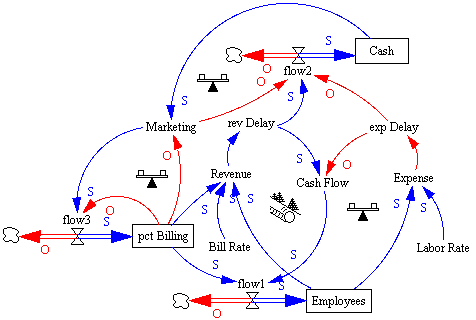Systems thinking is the process of understanding how things influence one another within a whole. In nature, systems thinking examples include ecosystems in which various elements such as air, water, movement, plants, and animals work together to survive or perish. In organizations, systems consist of people, structures, and processes that work together to make an organization healthy or unhealthy.
 Systems Thinking has been defined as an approach to problem solving, by viewing "problems" as parts of an overall system, rather than reacting to specific part, outcomes or events and potentially contributing to further development of unintended consequences. Systems thinking is not one thing but a set of habits or practices [1] within a framework that is based on the belief that the component parts of a system can best be understood in the context of relationships with each other and with other systems, rather than in isolation. Systems thinking focuses on cyclical rather than linear cause and effect. Systems Thinking has been defined as an approach to problem solving, by viewing "problems" as parts of an overall system, rather than reacting to specific part, outcomes or events and potentially contributing to further development of unintended consequences. Systems thinking is not one thing but a set of habits or practices [1] within a framework that is based on the belief that the component parts of a system can best be understood in the context of relationships with each other and with other systems, rather than in isolation. Systems thinking focuses on cyclical rather than linear cause and effect.
In science systems, it is argued that the only way to fully understand why a problem or element occurs and persists is to understand the parts in relation to the whole.[2] Standing in contrast to Descartes's scientific reductionism and philosophical analysis, it proposes to view systems in a holistic manner. Consistent with systems philosophy, systems thinking concerns an understanding of a system by examining the linkages and interactions between the elements that compose the entirety of the system.
Science systems thinking attempts to illustrate that events are separated by distance and time and that small catalytic events can cause large changes in complex systems. Acknowledging that an improvement in one area of a system can adversely affect another area of the system, it promotes organizational communication at all levels in order to avoid the silo effect. Systems thinking techniques may be used to study any kind of system — natural, scientific, engineered, human, or conceptual.
Read more...
|
Universal Systems Language
Unlike traditional languages, the Universal Systems Language (USL) is based on a preventative instead of a curative paradigm.[1][2][3][4] Based on systems theory, to a great extent derived from lessons learned from the Apollo onboard flight software effort, USL has evolved over several decades and taken on multiple dimensions as a Systems Engineering approach.
According to its users, USL eliminates any preconceived notions because it is a world unto itself–a completely different way to think about systems. Instead of object-oriented and model-driven systems, the designer thinks in terms of system-oriented objects (SOOs) and system-driven models. Much of what seems counterintuitive with traditional approaches, which tend to be software-centric, becomes intuitive with this systems-centric approach.
USL was created for designing systems with significantly increased reliability, higher productivity, and lower risk. It was designed with the following objectives in mind:
- reduce complexity and bring clarity into the thinking process;
- ensure correctness by inherent, universal, built-in language properties;
- ensure seamless integration from systems to software;
- ensure traceability and evolvability,
- develop unambiguous requirements, specifications, and design;
- ensure that there are no interface errors in a system design and its derivatives;
- maximize inherent reuse;
- ensure that every model captures real-time execution semantics (for example, asynchronous and distributed);
- establish automatic generation of much of design, reducing the need for designers’ involvement in implementation details;
- establish automatic generation of 100 percent, fully production-ready code, from system specifications, for any kind or size of software application; and
- eliminate the need for a high percentage of testing without compromising reliability.
USL together with its automation[5], can address these objectives because of the systems theory that forms its foundations. It also takes roots from other sources–other real-world systems and formal linguistics, methods, and object technologies.
Read more...
 Mutual Causality in Buddhism and General Systems Theory: The Dharma of Natural System (Buddhist Studies Series) (Paperback) Mutual Causality in Buddhism and General Systems Theory: The Dharma of Natural System (Buddhist Studies Series) (Paperback)
ISBN: 0791406377
Publisher: State Univ of New York Pr
International Journal of Management, Jun 2002 by Capps, Charles J III, Hazen, Samuel E
 Strategists derive further insights into the affect of trends and possible future scenarios when examining the components of the external environment using von Bertalanffy's "General Systems Theory". There is a deeper understanding of the inter-relatedness of the influencing factors in the environment when applying systems theory to the strategic planning model. This approach produces a richer, and thus better, appreciation of the sub-systems that compose the larger synergistic general system that is our global total system. The addition of von Bertalanffy's systems theory perspective to the strategic scanning of the future to 2050 seems practical and wise. Strategists derive further insights into the affect of trends and possible future scenarios when examining the components of the external environment using von Bertalanffy's "General Systems Theory". There is a deeper understanding of the inter-relatedness of the influencing factors in the environment when applying systems theory to the strategic planning model. This approach produces a richer, and thus better, appreciation of the sub-systems that compose the larger synergistic general system that is our global total system. The addition of von Bertalanffy's systems theory perspective to the strategic scanning of the future to 2050 seems practical and wise.
"Tomorrow always arrives; the wise seek knowledge to prepare!" - Anonymous
Strategists perform environmental scanning by monitoring the globe for future opportunities and threats that will affect their organizations. The external environment is generally beyond the control of any organization and includes the following categories: the competition, the economy, social-cultural-demographic factors, political-legal-governmental aspects, technology, and the natural environment. Each of these categories is a sub-system of a larger system, when systems theory explains the strategic planning model. Therefore, this paper's thesis is that an understanding of general systems theory provides an enhanced appreciation of how each of these sub-systems interconnects and interacts. In addition, by using this conceptual approach, one may understand more deeply trends and the critical nature of the interplay between these various components.
"Japan Inc." is now strategically planning for the year 2025. Chinese strategic planners are projecting 2150. Recently, the Central Intelligence Agency (CIA) uncharacteristically released an unclassified document entitled, Global Trends 2015, for rare public consumption (Global Trends 2015, published by the CIA, 2001).1 Other respected sources, Which World?: Scenarios for the 21st Century, present similar trends and forecast through 2050 (Which World?: Scenarios for the 21st Century, published by California Institute of Technology, 2001).2 Using the lens of systems theory, we may see how trends and likely scenarios of the future global environment between 2015 and 2050 are connected. According to systems theory, a sub-system or trend is conceptually not in isolation of the global total system.
Read more...
Complex systems is the subject of a diverse variety of sciences and professional practice methods. It is often overshadowed by the representation of the natural organization with systems of equations, the main subject below. In the study of complex systems that are less usefully represented with equations various other kinds of narratives and methods for identifying, boundaries, exploring, designing and interacting with complex systems are used. A more broad view of the various disciplines and practice methodologies using the complex systems approach is found on the Encyclopedia of the Earth.[1]
The equations from which complex system models are developed generally derive from statistical physics, information theory and non-linear dynamics, and represent organized but unpredictable behaviors of systems of nature that are considered fundamentally complex. The physical manifestations of such systems cannot be defined, so the usual choice is to refer to "the system" as the mathematical information model, without referring to the undefined physical subject the model represents. One of a variety of journals using this approach to complexity is Complex Systems.
Such systems are used to model processes in computer science, biology[2], economics, physics and many other fields. It is also called complex systems theory, complexity science, study of complex systems, sciences of complexity, non-equilibrium physics, and historical physics. A variety of abstract theoretical complex systems is studied as a field of mathematics.
The key problems of complex systems are difficulties with their formal modeling and simulation. From such a perspective, in different research contexts complex systems are defined on the basis of their different attributes. Since all complex systems have many interconnected components, the science of networks and network theory are important aspects of the study of complex systems. A consensus regarding a single universal definition of complex system does not yet exist.
Read more...
|
|
|
|
|
|
Page 3 of 4 |
 Systems Thinking has been defined as an approach to problem solving, by viewing "problems" as parts of an overall system, rather than reacting to specific part, outcomes or events and potentially contributing to further development of unintended consequences. Systems thinking is not one thing but a set of habits or practices [1] within a framework that is based on the belief that the component parts of a system can best be understood in the context of relationships with each other and with other systems, rather than in isolation. Systems thinking focuses on cyclical rather than linear cause and effect.
Systems Thinking has been defined as an approach to problem solving, by viewing "problems" as parts of an overall system, rather than reacting to specific part, outcomes or events and potentially contributing to further development of unintended consequences. Systems thinking is not one thing but a set of habits or practices [1] within a framework that is based on the belief that the component parts of a system can best be understood in the context of relationships with each other and with other systems, rather than in isolation. Systems thinking focuses on cyclical rather than linear cause and effect.


 General Systems Theory
General Systems Theory


 Mutual Causality in Buddhism and General Systems Theory: The Dharma of Natural System (Buddhist Studies Series) (Paperback)
Mutual Causality in Buddhism and General Systems Theory: The Dharma of Natural System (Buddhist Studies Series) (Paperback) Strategists derive further insights into the affect of trends and possible future scenarios when examining the components of the external environment using von Bertalanffy's "General Systems Theory". There is a deeper understanding of the inter-relatedness of the influencing factors in the environment when applying systems theory to the strategic planning model. This approach produces a richer, and thus better, appreciation of the sub-systems that compose the larger synergistic general system that is our global total system. The addition of von Bertalanffy's systems theory perspective to the strategic scanning of the future to 2050 seems practical and wise.
Strategists derive further insights into the affect of trends and possible future scenarios when examining the components of the external environment using von Bertalanffy's "General Systems Theory". There is a deeper understanding of the inter-relatedness of the influencing factors in the environment when applying systems theory to the strategic planning model. This approach produces a richer, and thus better, appreciation of the sub-systems that compose the larger synergistic general system that is our global total system. The addition of von Bertalanffy's systems theory perspective to the strategic scanning of the future to 2050 seems practical and wise.

